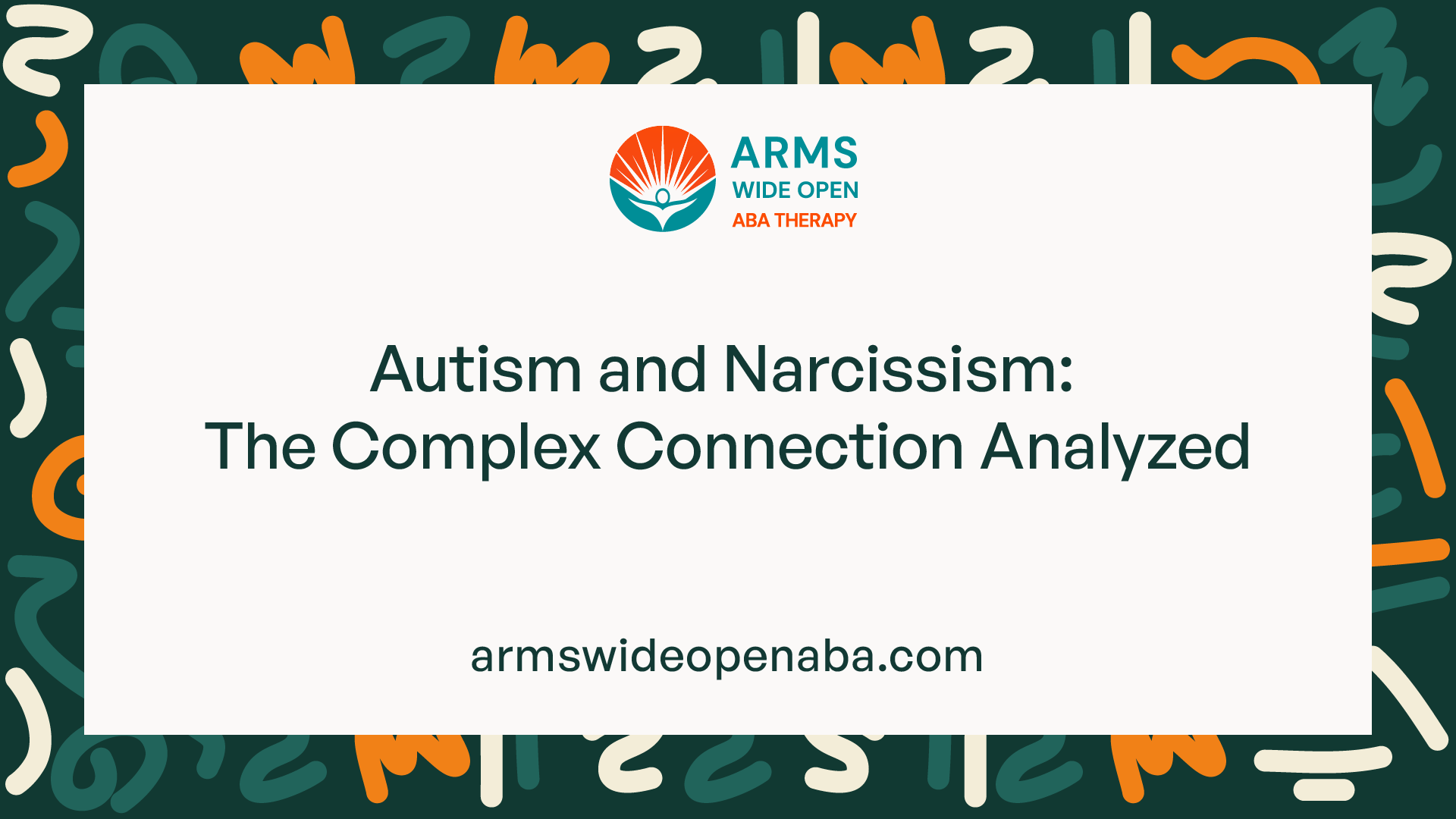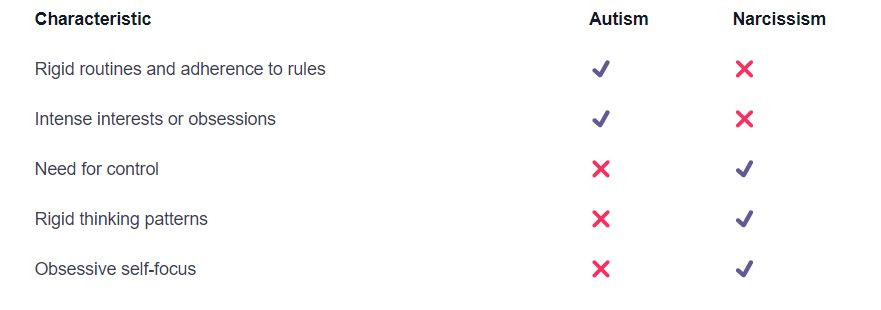Autism and Narcissism: The Complex Connection Analyzed
Unraveling the complex connection between autism and narcissism: shared traits, differentiating factors, and implications analyzed.

Understanding Autism and Narcissism
In order to comprehensively analyze the complex connection between autism and narcissism, it is important to first gain an understanding of each individual condition and their overlapping traits. This section will provide an introduction to autism, an introduction to narcissism, and explore the traits that connect the two.

An Introduction to Autism
Autism, also known as Autism Spectrum Disorder (ASD), is a neurodevelopmental disorder that affects social interaction, communication, and behavior. It is characterized by a wide range of symptoms and varying levels of impairment. Individuals with autism often have difficulties with social communication, repetitive behaviors, and sensory sensitivities.
An Introduction to Narcissism
Narcissism, on the other hand, is a personality trait characterized by an exaggerated sense of self-importance, a need for admiration, and a lack of empathy for others. It is important to note that narcissism exists on a spectrum, ranging from healthy self-esteem to pathological narcissistic personality disorder (NPD), which is a more severe form of narcissism.
The Overlapping Traits and Connection
While autism and narcissism may seem like contrasting conditions, there are certain traits that overlap between the two. These shared characteristics contribute to the complex connection between autism and narcissism. Some of the key overlapping traits include:

It is important to recognize that while there may be overlapping traits, autism and narcissism are distinct conditions with different underlying causes and diagnostic criteria. The connection between the two is complex and requires careful analysis to understand how these traits manifest in each condition.
By gaining a deeper understanding of autism, narcissism, and their shared traits, we can begin to explore the complexities of their connection. In the following sections, we will delve into the specific characteristics that differentiate autism from narcissism and examine the implications of this complex connection.
Shared Characteristics
Autism and narcissism share several characteristics that contribute to their complex connection. Understanding these shared traits can provide insights into the overlapping behaviors and challenges experienced by individuals with both conditions.
Social Interaction and Communication
Both autism and narcissism can impact social interaction and communication skills. Individuals with autism may struggle with social cues, nonverbal communication, and developing meaningful relationships. Similarly, individuals with narcissism may exhibit difficulties in empathizing with others, maintaining genuine connections, and displaying self-centered behaviors.

Sensory Sensitivities
Sensory sensitivities are another shared characteristic between autism and narcissism. Individuals with autism may experience heightened sensitivity or aversion to certain sensory stimuli, such as loud noises, bright lights, or certain textures. Similarly, individuals with narcissism may display sensitivity to criticism or rejection, often reacting strongly to perceived threats to their self-image.

Rigidity and Obsessive Behaviors
Both autism and narcissism can involve rigidity and obsessive behaviors, although in different ways. Individuals with autism may exhibit rigid routines, adherence to rules, and intense interests or obsessions. Similarly, individuals with narcissism may display a need for control, rigid thinking patterns, and obsessive self-focus.

Recognizing these shared characteristics can provide a starting point for understanding the complex connection between autism and narcissism. However, it is important to note that while there may be overlaps, each condition is distinct, and a comprehensive understanding requires a deeper exploration of their differentiating factors.
Differentiating Factors
While autism and narcissism share some common characteristics, there are distinct factors that set them apart. Understanding these differentiating factors is crucial in comprehending the complex connection between autism and narcissism.
Empathy and Emotional Awareness
Empathy and emotional awareness are areas where individuals with autism and narcissism often display contrasting traits. Individuals with autism may struggle with recognizing and understanding others' emotions, leading to difficulties in empathizing with them. On the other hand, individuals with narcissism may possess the ability to recognize emotions but struggle with genuine empathy. They may prioritize their own needs and feelings above others, resulting in a lack of empathy.

Self-Image and Grandiosity
A significant differentiation between autism and narcissism lies in self-image and grandiosity. Individuals with autism typically have a more modest and realistic view of themselves, often struggling with self-esteem and self-confidence due to challenges in social interactions. In contrast, individuals with narcissism may have an inflated sense of self-importance and exhibit grandiose behaviors. They may seek constant admiration and validation from others to maintain their self-image.

Theory of Mind and Perspective Taking
Theory of mind and perspective taking are areas where autism and narcissism diverge. Theory of mind refers to the ability to understand that others have different thoughts, beliefs, and perspectives. Individuals with autism often struggle with theory of mind, finding it challenging to comprehend others' viewpoints. In contrast, individuals with narcissism may have a good understanding of others' perspectives but may manipulate situations to serve their own interests.

Differentiating the factors between autism and narcissism helps us recognize the complexities of their connection. It is important to approach each condition with a unique understanding, considering the distinctive traits and characteristics associated with each. By understanding these differences, we can gain insights into the complexities of these conditions and provide appropriate support and interventions for individuals affected by them.
Exploring the Complex Connection
When delving into the intricate relationship between autism and narcissism, it is essential to explore the overlapping traits, potential for misdiagnosis, the role of co-occurring disorders, and the existing research and theories on this connection.
Overlapping Traits and Misdiagnosis
Autism and narcissism share certain characteristics that can lead to confusion and potential misdiagnosis. Both conditions may display challenges in social interaction and communication, as well as exhibit rigidity and obsessive behaviors. These overlapping traits can sometimes make it challenging to differentiate between the two conditions, particularly when assessing individuals who display narcissistic traits but might also have underlying autistic traits.
To better understand the complex connection between autism and narcissism, it is crucial to consider the individual's overall presentation and evaluate the presence of other key differentiating factors.
The Role of Co-occurring Disorders
Co-occurring disorders can further complicate the connection between autism and narcissism. Individuals with autism may also experience additional mental health conditions, such as anxiety, depression, or obsessive-compulsive disorder (OCD). Similarly, individuals with narcissistic traits may exhibit comorbid conditions, including antisocial personality disorder or borderline personality disorder.
The presence of co-occurring disorders can influence the manifestation of traits associated with both autism and narcissism, making it even more challenging to distinguish between the two conditions. Accurate diagnosis and understanding of these co-occurring disorders are crucial to developing appropriate treatment plans and providing effective support.
Research and Theories on the Connection
Extensive research has been conducted to explore the complex connection between autism and narcissism. Several theories have emerged, offering potential explanations for the overlapping traits and shared characteristics observed in individuals with these conditions.
One theory suggests that the connection between autism and narcissism may stem from impairments in empathy and emotional awareness. Both conditions are associated with difficulties in understanding and expressing emotions, albeit in different ways. Another theory explores the concept of self-image and grandiosity, suggesting that individuals with autism and narcissism may have distorted or exaggerated perceptions of themselves.
While research has shed light on the complex connection between autism and narcissism, further investigation is needed to fully understand the underlying mechanisms and establish clear diagnostic criteria. Continued research will contribute to improved diagnosis, treatment, and support for individuals with these conditions.
By exploring the overlapping traits, considering the role of co-occurring disorders, and delving into the existing research and theories, we can gain a deeper understanding of the complex connection between autism and narcissism. This knowledge is invaluable in providing effective support and developing appropriate interventions for individuals navigating the intricacies of these conditions.
Implications and Considerations
Understanding the complex connection between autism and narcissism has important implications for diagnosis, treatment, and support for individuals who exhibit overlapping traits. It is crucial to consider the impact of this connection and explore further avenues of study for better comprehension and future directions.
Impact on Diagnosis and Treatment
The recognition of the connection between autism and narcissism has significant implications for the diagnosis and treatment of individuals who exhibit traits from both conditions. Professionals in the field need to be aware of the potential overlap and consider these factors during evaluations. This can help prevent misdiagnosis and ensure that individuals receive the appropriate support and interventions tailored to their specific needs.
Implications
- Awareness of the potential connection between autism and narcissism during diagnosis
- Preventing misdiagnosis and ensuring appropriate treatment
- Tailoring interventions to address the unique challenges faced by individuals with overlapping traits
Understanding and Supporting Individuals
Gaining a deeper understanding of the complex connection between autism and narcissism is crucial for providing effective support to individuals who exhibit overlapping traits. By recognizing and addressing both the shared characteristics and differentiating factors, professionals, caregivers, and society can offer the necessary understanding, empathy, and assistance.
Considerations
- Recognizing and addressing shared characteristics such as social interaction difficulties and sensory sensitivities
- Understanding and supporting individuals in navigating rigidity and obsessive behaviors
- Developing strategies to foster empathy and emotional awareness
- Providing guidance in managing self-image and grandiosity
- Promoting theory of mind and perspective-taking abilities
Further Study and Future Directions
While some research has explored the connection between autism and narcissism, there is still much to uncover. Further study is needed to delve deeper into this complex relationship and its potential underlying mechanisms. Future research can focus on investigating genetic, environmental, and neurobiological factors that contribute to the overlapping traits and connection between the two conditions.
Future Directions
- Investigating genetic factors that may contribute to the overlap between autism and narcissism
- Exploring environmental influences that impact the development of shared traits
- Examining neurobiological mechanisms underlying the connection
- Conducting longitudinal studies to gain a better understanding of the trajectory and outcomes of individuals with overlapping traits
By considering the implications of the connection between autism and narcissism, understanding and supporting individuals with overlapping traits, and fostering further study, we can advance our knowledge and ultimately improve the lives of those affected by these complex conditions.
Sources
https://www.abtaba.com/blog/autism-and-narcissism
https://www.brighterstridesaba.com/blog/autism-and-narcissism
https://elemy.wpengine.com/mood-disorders/autism-and-narcissism
Similar articles
We’re here to help you

Our team is here to assist you in this process. Contact us for any assistance.
it’s easy to apply
We Accept Most Insurances
Our in-network insurance partnerships make ABA therapy more accessible to families throughout our service areas.







Our Insurance Process
We'll request your insurance details to help us verify your plan's coverage for ABA therapy. Once we've received this information, we'll walk you through your benefits, including copayments, deductibles and out-of-pocket maximums, so you know what to expect in advance.
Our team will then handle the preauthorization and all the necessary paperwork.
.svg)





















.jpeg)


































.jpeg)




.jpeg)







.jpeg)











.jpeg)
















